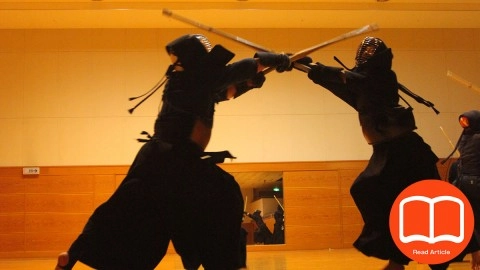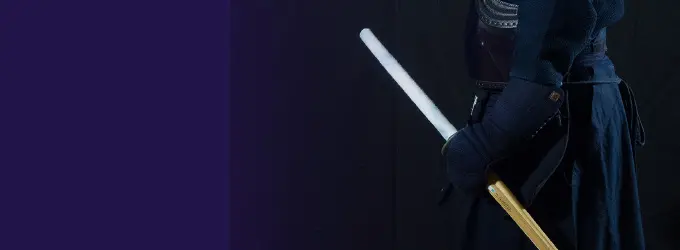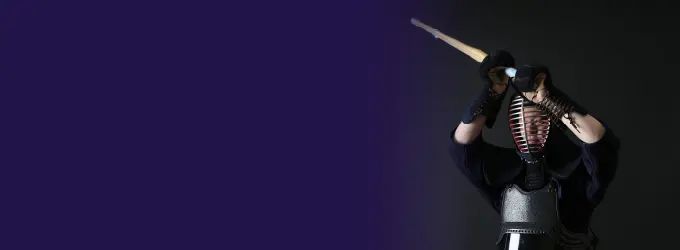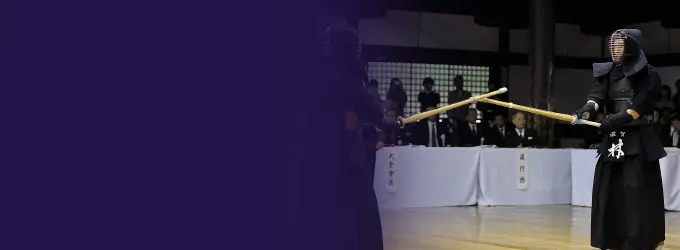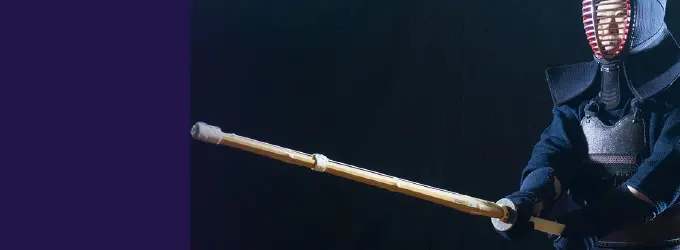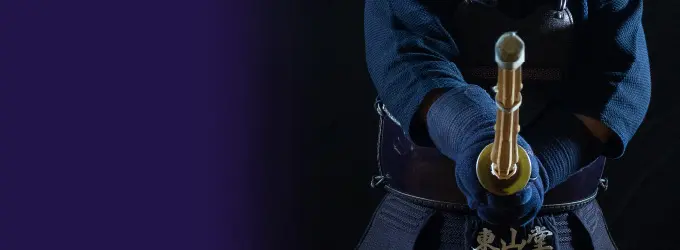Kendo Terminology
11 30, 2020
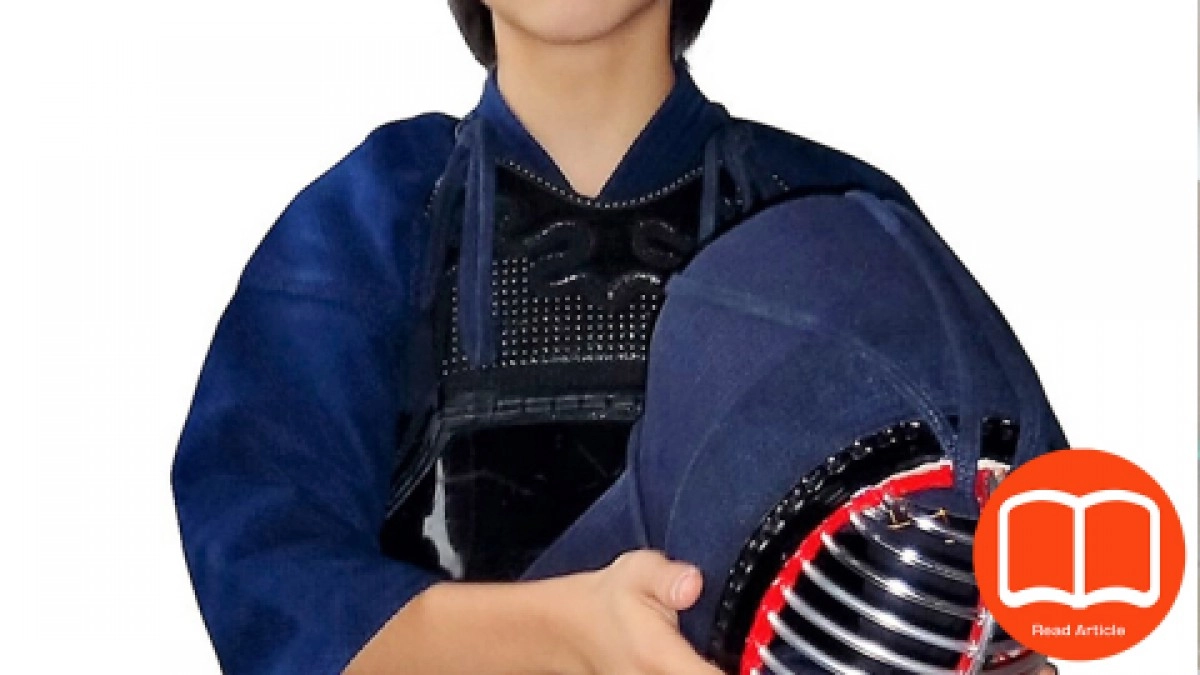
Defining the technical and special terms used in Kendo.
1.A
Ai-kakari
The form of practice in which both Motodachi and Kakarite quickly exchange waza with one another.
Ai-uchi
When both opponents perform a valid strike at the same time.
*In this case, the strikes made by the two fighters are considered invalid and the match continues.
All Japan Kendo Federation
The governing body for kendo and other martial arts in Japan. The dan and kyu titles are conferred by the All Japan Kendo Federation.
Ashi-sabaki
The way the feet move. (Footwork)
Ayumi-ashi
The footwork of alternating right and left foot movements. The same as the way one usually moves when walking.
2.B
Bokuto
A wooden sword used in the performance of Japanese kendo kata and for suburi.
3.C
Carbon fiber shinai
A shinai that is made of carbon instead of bamboo. It has the advantage of being more resilient than a normal shinai, but it has the disadvantage of feeling heavier and being expensive.
Chika-ma
A distance between the opponents that is closer than the distance of issoku-itto.
Choyaku-suburi
A type of swinging practice. As the shinai is swung forward both the left and right foot are moved forward. As the shinai is then drawn back, both feet will then be quickly drawn back.
Chudan Kamae
The most fundamental stance in Kendo. The right foot is forward while the left foot is back, so that one is able to move at any time. The left hand is placed at the end of the tsuka (grip) and the right hand is at the top of the shinai grip near the tsuka (guard). It is held so that both hands are in front of the navel.
4.D
Debana
The moment when the opponent initiates the movement to strike.
Dō
Armor warn to protect the torso. It is also one of the striking points.
Dogi
Clothing worn on the upper body. It is sometimes called "keiko-gi" but is officially known as a "kendo-gi.”
Dojo
A place for training in martial arts, such as Kendo. Originally, it was a Buddhist term for a place to practice meditation. It can also refer to an organization that teaches kendo.
5.F
Fudōshin
A mind that is unfazed by anything. A state of mind that cannot be perturbed by outside influence.
Fumikomi-ashi
An action made when striking where the right foot lands firm stomping the ground.
6.G
Gedan-no-kamae
A posture where the kensen of the shinai is lowered close to the floor from chu-dan kamae. In modern times, it has become one of a kamae used when performing the kendo kata and is not used in shinai kendo.
Gōgi
A discussion held by referees during a match to confirm or disagree with a decision or to discuss concerns or ask questions.
Gyaku-kote
A technique in which one strikes the opponent's left kote.
Gyaku-dō
A technique in which one strikes the opponent’s right dō when striking or being struck on the left side of the dō when receiving the strike.
7.H
Hakama
Clothing worn on the lower half of the body, under protective gear.
Hasso-no-kamae
Holding the sword vertically and pulling it to the body, this stance has the left foot forward. In modern times, it has become one of the postures for performing kendo kata and is not used in shinai kendo.
Hansoku
Prohibited actions such as going outside of the match area or dropping a shinai. Two (2) infractions shall be counted as an ippon for the opponent.
Hiki-waza
A generic term for a waza that is performed while moving backward from a tsuba-zeriai.
Hidari Jōdan
A stance with the left leg forward, holding the shinai above the head slightly tilted to the right. It is considered to be an aggressive stance that can be used to execute techniques quickly, while a large opening does appear in the dō.
Hiraki-ashi
The type of footwork employed when moving the body side to side.
Sub referee
Referee whose role is to support the main referee in a match. Two referees line up across from the main referee during a match.
Heel Supporter
A supporter worn by people who are unable to step into the foot due to injury to protect the heel.
8.I
Ichigan-nisoku Santan-shiriki
Words in the order of importance in the practice of Kendo. Beginning with the most import ‘eye’ to see the opponent’s movement. Next is the ‘footwork’ to control the body. Then the ‘courage’ to not be swayed by the situation. Lastly, the ‘power to perform waza’.
I-tsuku
This is a state in which you cannot react to your opponent's strikes because of a loss of concentration, etc.
Issoku-itto Maai
The most basic distance between opponents in kendo. You are able to strike with a single move forward from this distance. Closer than this will be chika-ma, whereyou are very close, and further away will be to-ma where the distance is far. The distance between these two will be different for each person.
Inasu
To deflect or soften the direction of a strike by the opponent with the shinai. For example, parrying an opponent's strikes.
9.J
Jigeiko
A type of training in which two individuals face each other while trying to find opening to strike in the same style of an actual match. Unlike match practice, there is no referee.
Jōdan
The stance in which the sword is lifted above the head. There are two variants of this stance: the Migi Jōdan, in which the sword is lifted directly from the chudan stance, and the Hidari Jōdan in which the left foot is put forward and the sword is tilted slightly to the right. Generally, when jōdan is simply stated, it is referring to Hidari Jōdan.
10.K
Kaeshi-do
The waza of receiving the opponent's strike with the surface of your shinai and then twisting the wrist to strike the opponent's dō.
Kakari-geiko
A form of practice dividing the motodachi and kakarite roles between two individuals. The Kakarite then quickly strikes the motodachi with waza for a decided period of time.
Kakarite
In kakari-geiko, a person who performs waza on the motodachi.
Katate-suburi
A form of suburi whereby the right and is removed and suburi is done from the standard kamae.
Kamiza
The side where sensei and elders are located in a dojo. If there is a Shinto shrine, this is the kamiza; if there is no Shinto shrine, the side farthest from the entrance is generally the kamiza.
Kiai
The momentum created from having focused on something. The vocalizations made during a match by the opponents is also known as kiai.
Kikentai-icchi
In addition to capturing an effective position while making a strike in a match, there is also the need to have the spirit of the attack, the shinai (or sword), and the body move in unity. This unified strike is also a requirement for making a valid strike.
Kissaki
The tip of a sword. In the case of a shinai, the correct term is "kensen".
Kiri-kaeshi
A type of basic practice. After striking the men from the front and colliding with the body, after which the left and right side of the men are struck alternatively. The receiver may also use their shinai to receive and perry each strike while the pair move in tandem.
Kōken Chiai
The word means "to build a better understanding of each other and better relationships through kendo.
Kodachi
A short wooden sword used in Japanese kendo kata, or short swords used in koryu kenjutsu, etc.
Kokkishin
A philosophy centered around self-denial and overcoming traits that are not considered morally or practically beneficial.
Kote
Protective equipment worn on the right and left hand and wrist. When referring to protective gear, the characters "甲手" and "籠手" are sometimes used. It is also one of the valid striking points.
Kote Supporter
A supporter worn on the inside of the kote. It softens impacts and relieves painful strikes at the time of impact.
Kote-men
To strike kote and then immediately afterwards to strike men. One of the most common techniques performed as part of training and is also seen during matches.
11.M
Migi Jōdan
The stance with the shinai lifted up from above the head from chudan.
Mitori-geiko
Practicing by watching the practice of others to learn techniques and timing.
Mukae-tsuki
A tsuki that is done not by striking the opponent, but by allowing the opponent to run into the shinai which has been squared onto their tsuki. It can be used to block an opponent's attack, but it can also be dangerous
Meikyo-shisui
A phrase that refers to a mind that is unperturbed and still like the surface of a mirror or calm unmoving water.
Men
Protective gear worn on the head. It is also one of the valid striking points.
Me-rei
Refers to the mutual act of showing courtesy through bowing at about a 15-degree angle while maintaining eye contact with your opponent. This is considered a vital display of respect in kendo.
Motodachi
The person who is on the receiving end of an opponent's strikes during kakari-geiko.
Mono-uchi
The portion of the shinai between the kensen and the naka-musubi. You must strike one of the opponents valid striking points with this portion of the shinai to make a valid strike. Synonymous with the term ‘datotsu-bu.’
Morote
Both hands.
12.N
Naka-musubi
The leather that is wrapped between the tip of the shinai and the tsuba. The position of the middle knot is about a quarter of the total length from the tip of the blade.
Nito (ryu)
A method of fighting with two shinai, one in the right hand and one in the left hand. In modern kendo, it is often called "nito" instead of "nito-ryu". In the early Showa era, nito was popular, especially in youth kendo. Nowadays there are very few practitioners. However, it remains popular among nito enthusiasts.
Nihon Kendo Kata
A form established by the All Japan Kendo Federation that is performed using a dull sword or bokuto. It is a successor to the Imperial Japanese Kendo kata established by the then Dai Nippon Butokukai in 1924. There are 7 kata performed with a normal tachi sword and 3 kodachi, which is a short sword, and are used for dan evaluation. It is often referred to simply as kendo kata, or kata.
13.O
Okuri-ashi
The basic footwork of Kendo. When moving forward, put out the right leg and immediately pull on the left leg. When moving backward, lower the left leg and immediately pull on the right leg.
14.S
Sazauki
A word that signifies the correct manner in which to sit in seiza. Sit on your left foot first when sitting on your knees and then stand with your right foot first when standing.
Sasakure
Damage to the shinai. Do not use shinai while it is cracked, as it is dangerous and can pierce the body or enter the eyes causing injury or death.
Sashi-men
A strike where the shinai is not raised but is struck by extending the hands out in front in a stabbing motion.
Sanku (Sankyu)
A shinai of three shaku nine sun (120 cm). The shinai used by college students and above should be within this length.
Sabunana (Sanna)
A shinai of three shaku seven sun (114 cm). The shinai used by junior high school students should be within this length.
Sabuhachi (sanhachi)
A shinai of three shaku eight sun (117 cm). The shinai used by high school students should be within this length.
Saburoku (sanroku)
A shinai of three shaku nine sun (111 cm). The shinai used by elementary school students and below should be within this length.
Shidachi
When practicing Nihon Kendo Kata, the individual that employs a technique in response to the opponent's movements. The vocalization made when striking is "To!”
Shinai
Bamboo swords used in practice and matches.
Shinai Kezuri
A tool for repairing the splintered parts of a shinai.
Shimoza
The side where a person of a lower position, such as a deshi or student, is located. The opposite of the Kamiza.
Chief Referee
A referee who takes the lead among the three referees, for example, giving a signal to start or end a match.
Shuhari
The word refers to the stages of kendo training and advancement. ‘Shu’ is to follow the teachings of one's teacher and learn the basics. ‘Ha’ is the stage to acquire the basics and refine one's sword in one's own way. ‘Ri’ refers the stage where you leave your teacher and establish your own sword.
Shodachi
The first blow delivered after a match has begun.
Suburi
The practice of swinging a shinai up and down, diagonally and in other directions in space, to learn how to move the shinai, perform footwork, and take up a kamae.
Suburi-ko
A product sold as a weight to attach to a shinai.
Suri-ashi
A form of footwork in which that the feet slide on the floor. The heel does not touch the ground but floats so that there is a gap of a sheet of paper.
Seichu-sen
A line that runs vertically through the center of the body, such as from the nose to the navel.
Sonkyo
Refers to a squatting position with both legs bent at the knees. This posture is taken at the beginning and end of a match or practice.
15.T
Tai-atari
Instead of passing by the side of the opponent after striking, the individual will crash directly into the opponent.
Tai-sabaki
The manner in which an individual moves or controls their body.
Tasuki
A piece of cloth used to distinguish between individuals or teams in a match or competition. It is tied to the himo that holds the dō in place.
Tare
The armor that is worn under the dō and around the waist.
Tare Name
A bag with your name written on it that is attached to the centermost ōdare or ‘flap’. The official name is "zekken" and is commonly called this. However, it is also often called "tare name.” The name of one’s school or dojo is written horizontally on the top, and the surname of the individual is written vertically below it. Many people use it as a pocket, for example, to put a tasuki inside.
Team Competition (dantai-sen)
A five-on-five match format. The order of the match is: senpo, jiho, chuken, fukusho, and taisho. The team with the highest number of winning individuals wins. If there are less than 5 members in a team, (the team may have 3 or 4) in the case of 3 players, if the jiho and fukusho lose the match is lost by default.
Tanden
It generally refers to the center of the body, below the navel. It is thought to be enriched by containing the ki (spirit). More precisely, the tanden is found just below the umbilicus while other parts of the body are believed to contain other tandens.
Tsuka (hilt)
The part of a shinai that is held in the hand, unlike than the blade portion of the shinai.
Tsuki
A technique of striking the tsukidare under the chin with the tip of the sword. The tsuki is only valid for high school students and above in matches.
Tsugi-ashi
The left foot is drawn forward close to the right foot to allow for more momentum to be created for making a strike.
Tsuba (guard)
Attached between the blade and the handle of the shinai to protect the hand from an opponent's shinai. It can be removed when storing a shinai.
Tsuba-zeriai
A state in which the two opponents are close to each other after striking each other so that the tsuba will or will almost touch.
Tsuba-dome
Attached to the shinai to secure the tsuba to the shinai. There is also a type in which the tsuba and the tsuba-dome are integrated as one.
Tsuru
A cord that holds the shinai's tip leather, middle knot, and handle leather together.
Tō-ma
A distance between individuals farther than the issoku-itto distance
The life-giving sword
Concept that states that kendo is not for killing, but for making use of its elements for character building.
Training for a match
Practice performed in the same way as the game. A practice match in Kendo.
16.U
Uchitachi
When practicing Nihon Kendo Kata, the individual that initiates the technique first. The vocalization or ‘hassei’ for this strike is "Ya!
17.W
Waki-gamae
A stance taken with the left foot forward and the sword hidden behind the waist so that the length is not visible to the opponent. In modern times, it has become one of the stances when performing kendo kata and is not used in shinai kendo.
18.Y
Yukodatotsu
A strike made in which the ki, ken, and tai are unified. A strike that results in an Ippon in a match.
19.Z
Zanshin
A state of mind that is maintained even after a strike in which one’s focus and preparedness are not weakened or distracted. It is one of the conditions for effective striking.
